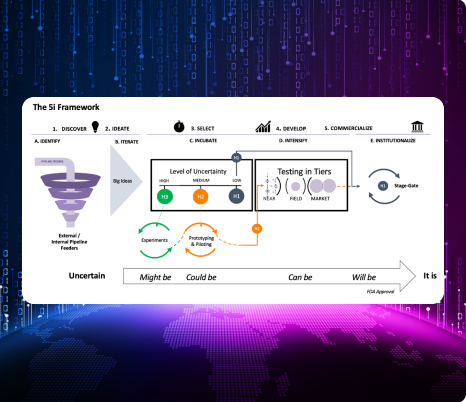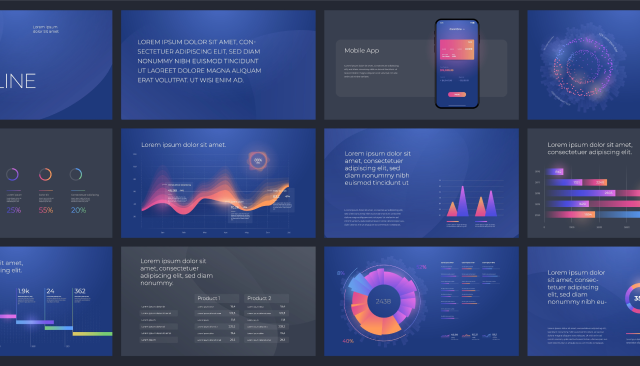Services
Leverage Human Ingenuity

Solve the World’s Biggest Health Challenges

Leverage Data-Driven Innovation Process - Close the Gap Between Today and Sustainable Growth
Innovative organizations understand they cannot leave innovation to chance, especially in the current fast-changing, uncertain environment. They leverage human ingenuity to solve the biggest health challenges. They bring together technological, business and medical experts to create vast networks of thoughts and ideas.
We are with you at every step of your innovation process, from market assessment, through ideation sprints, selection and development of innovative solutions and successful commercialization.
Enterprise Offerings

(Innovation Capabilities Assessment)
Innovation Capabilities Assessment
The most common reason why companies don’t meet their strategic goals is the gap between aspirations (why and what) with capabilities (how). This gap can be addressed by InnoSurvey®. Created from the analysis of the biggest world’s business innovation database of 5,000+ companies in 105 countries, the InnoSurvey® is a unique, evidence-based 360-assessment of your company’s innovation capabilities, leadership style, culture, and innovation personas. It allows you to benchmark your organization with industry peers and innovators. You will be able to identify your strengths, weaknesses, and untapped potential, and get actionable insights to enhance your innovation culture and meet your strategic goals.
Strategic Market Assessment
The second most common reason for not meeting strategic goals is insufficient understanding of market forces that affect your industry. A thorough market assessment based on PESTLED (Political, Economic, Societal, Technology, Legal, Environmental and Demographic trends), combined with Scenario Planning can address this gap.
The PESTLED360™ tool helps to identify Opportunities and Threats in the market and categorize them based on the level of uncertainty. To deal with future uncertainties, several different scenarios are investigated. The aim of scenario thinking is to identify important strategic uncertainties and to explore how they might play out in the future and affect the company’s business.


Innovation Sprints
Innovation sprints help to explore and learn before formulating company’s strategic initiatives, or to find solutions to difficult problems. The full sprint starts with the market forces assessment, using PESTLED360™, scenario mapping and selecting a few challenges. A diverse audience is invited to the ideation campaign, including workshops and online Ideation360™ tool, to provide a broad range of ideas on how to solve selected challenges. Individual ideas are clustered with the help of AI. Clusters are refined, and a few big ideas are formulated and tested for customer value, feasibility, market fit, profitability, and strategic fit. As a result, 2-3 big ideas move forward as official innovation projects.
Ideation360™ allows continuous monitoring of the status of ideation campaigns, such as number of ideas submitted, participants engagement, number, and status of clusters. Parked ideas stay in the system and can be accessed anytime.
For better results, the sprint should include a diverse group of employees and external stakeholders (e.g. advisors, customers, vendors).
Innovation Playbook
Finally, the third most common reason for failure is a disconnect between the business and innovation strategy goals. Innovation Playbook combines processes described above into a seamless structure for decision making, tools for ideation, and linkages to other processes for development and commercialization. It helps to prioritize your innovation projects around the business strategy. Also, it lays the foundation for building the right capabilities, culture, leadership, skills, and the fundamental language of innovation, along with metrics that will help the company to stay on track. It provides a roadmap for successful innovation that supports the sustainable growth of the company.
Traditionally the innovation process had four phases: ideation, selection, development, and commercialization. However, when working in a complex environment, a more comprehensive approach is needed. For this, we use the 5i model, which expands on these classical phases from ideation to commercialization and includes Identify, Iterate, Incubate, Intensify, and Institutionalize. It can be adapted to the needs of any organization, big or small, that wants to grow sustainably through innovation.



DIVE Commercialization De-risking Framework
Not all commercial launches in our industry are successful. In fact, less than 10% are considered globally excellent, according to IQVIA launch tracking reports. If launch success is a predominant concern, the DIVE Commercialization De-risking Framework, flexible and adjustable, is the best place to start. Successful commercialization provides the revenue stream, without which future innovations may not be possible. But launch is not an event. Instead, it is an iterative process that begins from the very first idea and “works backwards” from the aspiration of future success.
- There are four aspects of commercialization to be deployed skillfully to successfully launch your innovative product or service:
Discovery is a deep understanding of the market, stakeholders, and competitors. Typically, it includes defining and quantifying the unmet need, market definition and size, market forces assessment, competitive and stakeholder analyses. - Innovation is a unique, differentiated, value-adding solution that addresses the unmet need. It starts with desired product positioning and related target product profile (or minimum viable product in case of a software), and then proceeds to the product development stage, with the right evidence generation strategy, regulatory strategy and IP strategy.
- Value is about creating market value of your new product or service and turning it into a successful brand. In other words, this is your global marketing strategy, including segmentation and targeting, customer personas, value propositions and messages, pricing, and market access strategy.
- Execution has two aspects:
- Internal – focused on scaling up the company and building capabilities (resources and training).
- External – go-to-market strategies (cross-functional tactical plans, including omnichannel communication and metrics).
They are not meant as a linear process, but rather a set of skills to continuously iterate and adjust our market understanding, product development, marketing strategy and tactics that will make the launch more successful. In the case of a specific product or service launch, these building blocks can be turned into a launch excellence process with timelines and deliverables.
Emerging Companies Offerings
Emerging companies create the most breakthrough innovations while Founders and CEOs navigate the complex environment of ever-changing regulations, scarce funding and tight budgets, market competition, and the need to scale up the company while maintaining the agile culture. They deserve all the help they can get.
We offer three modules of clearly defined customized and affordable services for startups & emerging companies:

Pitch Deck
- Analysis and expert advisory on your solution and your current enterprise strategy.
- Development of the pitch deck for investors and the fundraising strategy.
- Deliverable: Pitch Deck
Scaling Up
- Analysis of the company’s strategies and objectives.
- Current company capabilities assessment and benchmark versus industry peers (InnoSurvey®) with specific recommendations.
- Deliverable: Scale Up Recommendations
It is a 2-month engagement through weekly 1-hour sessions and advisory in between.


Go-to-Market Strategy
- Commercial readiness assessment.
- Coaching on the GTM Strategy development and tactical plan
- Deliverables: Commercial Readiness Report and GTM Canvas.
It is a 3-month engagement through weekly 2-hour sessions and advisory in between.

